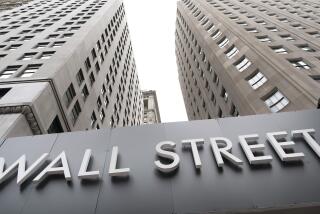How We Put It Together : There Are Many Ways to Rank Firms--Including Our Subjective Mix of 5 Criteria
The goal of this special tabloid is to put a filter across the stream of numbers that pour out of Californiaâs public companies every year, capture the most important information, and use it to present a snapshot of the health of the stateâs key businesses.
As is true in school, work and life in general, subjectivity is an issue here. There are many ways to rank businesses, and what is âfairâ in comparing companies is in the eye of the beholder.
This article explains how, and why, we did what we did.
The Times 100
This is the second year weâve used a proprietary system to create the primary Times 100 list (on Pages 6 and 7). These companies, led this year by Intel Corp., have the best average rankings across five key criteria.
Any ranking system is, of course, arbitrary. Our Times 100 list seeks to identify California-based companies that are the âmost successfulâ right now, but it is not intended to predict the future.
Indeed, other lists in this section, such as Sales 100, Sales Growth 100 and Stock Price Gain 100, may do a better job of pointing to specific companies that have the greatest momentum in terms of sales, earnings, investment return and other barometers of success.
The official Times 100 list, in contrast, is derived from a subjective mix of five criteria we chose. Those measures are described in detail below.
Last year, after the initial use of this proprietary system, we sent the Times 100 section to 65 economists across the state and asked for their opinions. They made many suggestions, some of which are reflected in this yearâs section.
Despite the arbitrary nature of the Times 100 ranking system and their own quibbles, most who wrote back told us to keep the system.
âI like it because I have a strong preference for simplicity and transparency in matters like this,â wrote Alan Williams, an economist at Rand Corp. in Santa Monica.
âThe Times 100 is an informative and well-constructed piece,â wrote Walter W. Perlick, dean of the School of Business Administration at Cal State Sacramento.
Some economists suggested weighting or normalizing the rankings, but we found this would not have made much difference in the results.
A few economists questioned using the one-year stock price change as one of the factors, because, as William P. Jennings at Cal State Northridge put it, âit may tend to give undue importance to companies that previously did badly, were the subject of takeover rumors near the end of the year or other factors which are not what the Times 100 list is looking to reward.â
Kon Lai, at Cal State Los Angeles, made a similar point: âShare prices can be influenced excessively by investorsâ sentiments, especially over the short term.â
These comments gave us pause, but in the end we decided to continue using stock price as one of the five criteria, in part because it reflects investorsâ emotions about individual companies.
*
To generate the Times 100 list, we first start with companies that have reached a certain critical mass: From a total of 1,117 public California companies, we cut that list about in half, by requiring a company to have at least $50 million in annual sales, $25 million in shareholder equity, two consecutive years of positive return on equity and a continuous share price history.
Those companies then were ranked by the five main criteria, and the ranks were averaged to produce a final score for each company. The lowest (i.e., best) score, Intelâs, was 27.8, which means that 27.8 was its average rank among the five categories.
As with the blind men describing the elephant, each factor tells only part of the story, but combined, they reveal a fuller picture of a companyâs success.
The five measures used in the Times 100 list:
* Market capitalization as of April 18. This is a companyâs stock price times the number of shares outstanding.
Unlike âbook value,â which is the theoretical liquidation value of a companyâs assets, market cap reflects what investors think a company is intrinsically worth. As such, it can vary tremendously depending on how glum or optimistic Wall Street feels.
* Total sales. As with market cap, companies with higher total sales will rank higher on our list, all other things being equal. Sales are a basic measure of a companyâs success because they tell you the size of the market for a companyâs products or services.
But of course, this measure makes no distinction between a high-sales company that is stagnating and one that is still growing. And a company may have high sales, yet generate little profit on those sales.
* Sales growth. We measure the percentage change in sales in the most recent four quarters, most often calendar year 1996, versus the previous four. The bigger the increase, the higher a companyâs ranking, all other things being equal.
The weakness in this measure: It doesnât distinguish between companies growing internally and those growing purely by acquisition. Sales growth can come at a price--if a company goes too deeply into debt to buy a rival or complementary business.
* Stock price change in the 52 weeks ended April 18. We measure the percentage change in each companyâs stock price over the previous 52 weeks so that the biggest gainers naturally get a higher ranking, all other things being equal.
Share price gain is perhaps the most basic measure of Wall Streetâs enthusiasm, of course. But in the short run, investors can be far too optimistic--or pessimistic--in judging a âfairâ stock price for a company.
Some companies whose shares soared over the last year may merely be benefiting from a sector fad. Othersâ prices may have been unreasonably depressed a year ago.
* Return on equity. Return on equity is a measure of the bottom line--the amount of profit earned on the capital shareholders have invested in a company.
We rank companies by the average annual percentage return on equity over the last two years (1995 and 1996). Using the two-year average figure prevents a single year of extraordinary gains from distorting the results.
Still, even return on equity can be misleading. Some companies are highly leveraged and operate on a significant amount of borrowed capital, with very little shareholder equity. Thus, a small amount of earnings can produce a high return on equity.
Also, some companies by nature can operate with much less shareholder equity than others.
General Background
Because fiscal years vary and results are reported quarterly, all companies cannot be compared directly on their performances for calendar year 1996.
An approximation of 1996 was created for every company, using data collected and analyzed by Market Guide Inc., a financial information services firm in Lake Success, N.Y. Because Market Guide updates its data as quickly as possible, â1996â in this section will in some cases mean the four quarters ended as late as March 30.
Overall, the database for this section covers 1,117 publicly held California companies traded on the three major U.S. stock markets.
Market Guide relies on its own databases and on corporate 10-Q and 10-K reports filed with the Securities and Exchange Commission, annual reports, surveys, news releases and other sources. For some charts, as indicated, the data were provided by other data companies or by government institutions.
Most of the lists were created by The Times using Market Guideâs CD-ROM product âMarket Guide for Windows.â
For year-to-year comparisons, the figures for 1996 (or the four quarters approximating the calendar year) are compared with the corresponding four quarters the year earlier.
Unlike balance sheet and income statement data, which is reported several weeks or months after the period in question, stock price and market value information changes daily. For that data, the section uses closing stock prices of April 18.
Some classes of shares arenât tracked by Market Guide, and, in a few cases, this might have changed a companyâs rank in some tables because stock price information and market capitalization information might have been affected.
However, an effort was made to identify and adjust for multiple classes in the published lists. For example, PacifiCare Health Systems Inc. would have ranked lower on the Market Value 100 chart if all share classes had not been taken into account.
Readers should note that data are sometimes reported late or arenât filed at all. This section reflects the best available information at the deadline for publication.
There can be many reasons for late or missing data, but often the company involved is troubled or has had accounting problems.
Market Guide, founded in 1983, compiles and sells comprehensive financial and descriptive information on public companies trading on the New York and American stock exchanges and on Nasdaq and other market systems.
Market Guide can be reached at 2001 Marcus Ave., Lake Success, NY 11042-1011. Telephone: (516) 327-2400.
Other Notes:
* Only companies with $10 million or more in annual sales were considered for the Wall Street High Fliers, Fastest Profit Growth and Gazelle 100 charts.
* Only companies with $50 million or more in annual sales, $25 million or more in shareholder equity and two years of positive return on equity were considered for the Return on Equity 100 chart.
* Although numbers have been rounded and there may appear to be ties, rankings are based on the figure before rounding.
* âSalesâ exclude any revenue from discontinued operations.
For banks and savings and loans, sales equals gross interest income. (Bank revenues are often measured in other ways.) For insurance firms, sales equals the sum of earned premiums, realized gains or losses from investments and net investment income.
* Real estate investment trusts (REITs) were not included in the Sales Growth 100 chart.
* Return on equity measures the percentage profit a company earns for every dollar common stockholders have invested in the firm. It is defined as income available to common shareholders divided by the average common shareholder equity.
More to Read
Inside the business of entertainment
The Wide Shot brings you news, analysis and insights on everything from streaming wars to production â and what it all means for the future.
You may occasionally receive promotional content from the Los Angeles Times.









